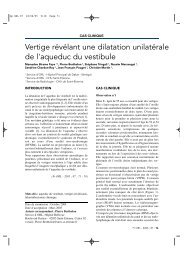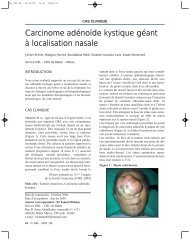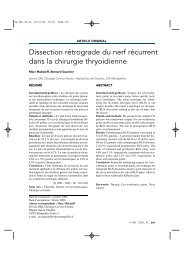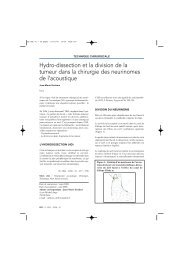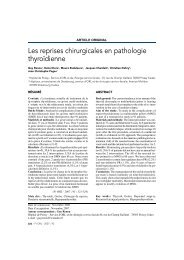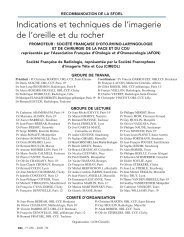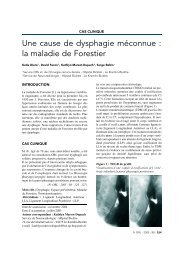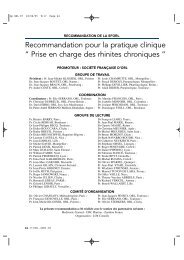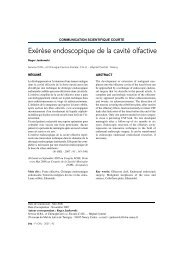ORL 93 AW - French Oto-Rhino-Laryngology
ORL 93 AW - French Oto-Rhino-Laryngology
ORL 93 AW - French Oto-Rhino-Laryngology
You also want an ePaper? Increase the reach of your titles
YUMPU automatically turns print PDFs into web optimized ePapers that Google loves.
INTRODUCTION<br />
Pott’s puffy tumour is characterized by frontal osteomyelitis<br />
causing erosion of the anterior wall of the fro ntal<br />
sinus and subperiosteal abscess [1,2], pre s e n t i n g<br />
with fluctuating, painful swelling of the forehead [1].<br />
It is a complication of frontal sinusitis, or, more rarely,<br />
t rauma to this region [2,3]. The pat h ogens most freq<br />
u e n t ly incri m i n ated are Stap hylococcus aure u s ,<br />
Streptococci and anaerobic bacteria [1,3]. The use of<br />
antibiotics has decreased the incidence of this complication<br />
of sinusitis [4,5].<br />
CASE REPORT<br />
A 32-year-old, male Caucasian patient presented with<br />
a one-month history of frontal headache and nasal obstruction.<br />
Clinical examination revealed bilateral frontal<br />
and periorbital oedema. This patient reported a history<br />
of heroin use. Computed tomography of the face<br />
revealed fe at u res of pansinusitis with a bone defe c t<br />
measuring about 1 cm in diameter in the anterior wall<br />
of the right frontal sinus, opacifi c ation of the right fro ntal<br />
sinus and thickening of adjacent epicranial tissues.<br />
Tre atment consisted of surge ry and antibiotics. A combined<br />
endoscopic and open incision (bu t t e r fly incision),<br />
was perfo rm e d, fo l l owed by surgical dra i n age of the<br />
abscess with resection of necrotic fragments, and obliteration<br />
of the right frontal sinus with medium viscosity<br />
bone cement. A sample of the contents of the abscess<br />
was collected for bacteri o l ogical culture. Initial<br />
antibiotic therapy consisted of empirical tre atment with<br />
intravenous gentamicin and clindamycin. As cultures<br />
we re negat ive, this tre atment was continued for one<br />
week, fo l l owed by oral cipro fl oxacin for six we e k s .<br />
B ro a d - s p e c t rum antibiotics we re used immediat e ly<br />
postoperatively and in the longer term due to the severity<br />
of the infection.<br />
The postoperative course was uneventful. Six months<br />
later, no abnormality was detected on clinical examin<br />
ation and computed tomograp hy showed opacifi c ation<br />
of the right frontal sinus with no pat h o l ogical signs.<br />
The patient was asymptomatic 14 months after surge ry.<br />
DISCUSSION<br />
Pott’s puffy tumour was described by Percivall Pott in<br />
1760 in Injuries of the Head from External Vi o l e n c e<br />
[3] as a complication of trauma. This disease was subsequently<br />
observed as a complication of frontal sinusitis<br />
[2]. It has become very rare since the age of anti-<br />
351 - Fr <strong>ORL</strong> - 2007 ; <strong>93</strong><br />
Pott’s puffy tumour<br />
biotics, with very few cases reported in the recent literature<br />
[2,4,5]. This disease is more frequent in children<br />
[2] and young male adults [6].<br />
The nasal sinus infection can be responsible for frontal<br />
osteomyelitis by direct extension of infection to bone<br />
or by thrombophlebitis of diploic veins. This extension<br />
of frontal osteomyelitis can erode the anterior wall of<br />
the frontal sinus and fo rm a subperiosteal abscess ge n erating<br />
a fl u c t u ating and painful swelling of the fo rehead<br />
[1].<br />
The diagnosis of Pott’s puffy tumour must be considered<br />
when clinical ex a m i n ation reveals a fl u c t u ating and<br />
painful swelling of the forehead in a patient with frontal<br />
sinusitis or a history of trauma to this region. The<br />
diagnosis is confirmed by CT examination of the face<br />
[1,5].<br />
This case rep o rt presented the typical fe at u res of the<br />
disease: young male adult with pansinusitis and a very<br />
painful fluctuating swelling of the forehead.<br />
Treatment consists of surgical drainage of the abscess,<br />
excision of necrotic fragments and intravenous antibiotics<br />
for 6 weeks, adapted to the pat h ogen [1,6].<br />
S u rge ry via a combined ap p ro a ch (endoscopic and<br />
open) gives good results [6]. As exposure of the entire<br />
frontal sinus and resection of all pathological mucosa<br />
is essential, obl i t e ration of the frontal sinus can be easily<br />
performed [1]. Obliteration materials may be synthet<br />
i c, such as hy d rox yap atite cement, or nat u ral: bone,<br />
fat or cart i l age [7]. Hydrox yap atite cement is a safe and<br />
e ffe c t ive obl i t e ration mat e rial for infected frontal sinu s<br />
and for reconstruction of frontal sinus defects [8]. This<br />
t e chnique is associated with minimal morbidity and can<br />
achieve complete osseointegration [8,9]. Topical treatment<br />
is also important with nasal vasoconstrictors and<br />
mucolytics [6].<br />
Pott’s puffy tumour can be complicated by potentially<br />
fatal intracranial extension such as extradural or subdural<br />
empyema, cerebral abscess and/or cerebral vein<br />
thrombosis [10].<br />
CONCLUSION<br />
C o m p l i c ations of sinusitis have decreased as a re s u l t<br />
of the use of antibiotics, but continue to occur sporadically.<br />
Ear, nose and throat surgeons and primary care<br />
physicians must therefore be aware of this possibility.<br />
Pott’s puffy tumour, although very rare, can be comp<br />
l i c ated by intra c ranial extension that can be fatal. Po t t ’s



